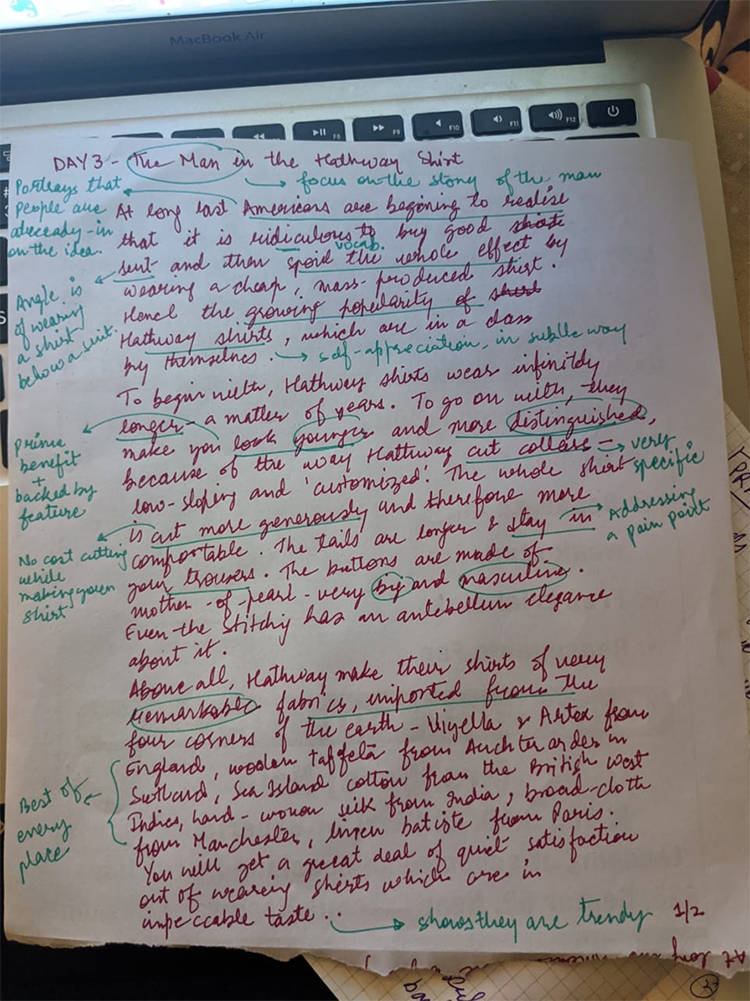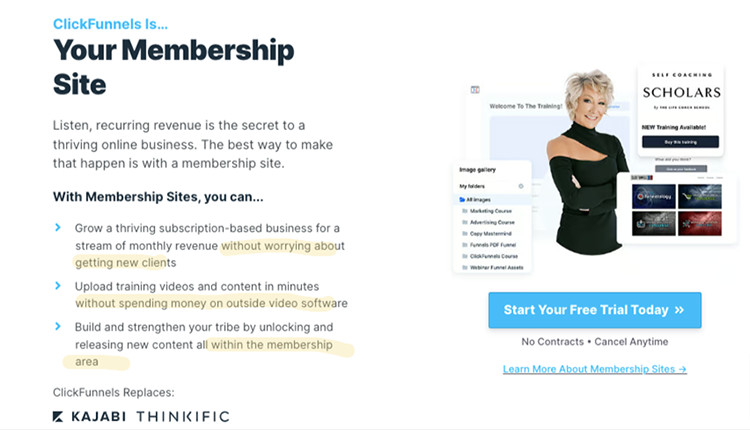Free
6 Copywriting Exercises That Can Sharpen Your Skills
Want to improve your copywriting skills? Look no further! We’ve got 6 copywriting exercises that will sharpen your abilities and make you a pro at writing high-converting copy.
Exercise #1: Handwriting Great Copy
Hand-copying legendary ads and copy is one of the best ways to develop your copywriting skills. By immersing yourself in the minds of successful copywriters, you’ll learn psychological triggers, conversion strategies, and how to create a seamless flow in your own writing.
To get started, check out the Facebook Ads Library to see what ads your favorite influencers are running. Analyze the ads’ hooks, solutions, features, benefits, customer awareness, CTAs, and any guarantees, scarcity, or urgency they use.
For vintage ads, visit Swiped.co, where you can find classic ads from renowned marketers. It’s a valuable resource to practice hand-copying and learn from the best.
To enhance the effectiveness of hand-copying, be sure to write by hand instead of typing. This engages different parts of your brain and allows for a deeper analysis of each line.
Hand-copying vintage and modern ads regularly will greatly improve your copywriting skills. Make it a habit and consider checking out Jim’s book, Copywriting Secrets, for even more insight into effective copy strategies.

So, start hand-copying and watch your copywriting soar to new heights!
Exercise #2: The “So What?” Test
Want to take your copy to the next level? Try running it through the “so what?” test. Put yourself in your audience’s shoes and evaluate each word and sentence. Ask yourself, “So what? What does this add to the conversation? Does it move them closer to where I want them to be?”
If a word or sentence doesn’t contribute or can’t pass the “so what?” test, consider removing it. After all, the goal is to grab and keep attention. Boring or filler text will only distract and potentially lose your hard-earned attention.
For example, let’s apply the “So What?” test to a high-end camera that boasts superior low-light capabilities:
Brand: Our camera takes amazing photos in low light.
Customer: So what?
Brand: You can capture beautiful images during sunsets or in dimly lit restaurants.
Customer: So what?
Brand: You won’t miss important moments because of poor lighting.
Customer: So what?
Brand: You can create and share beautiful memories, regardless of lighting conditions.
Customer: Where can I buy it?!
By answering the “so what?” questions, we’ve addressed the customer’s pain point and shown them how our camera can solve their problem. This exercise helps you speak directly to what your customer wants, making your offer more appealing to them.
You can also apply the “so what?” test to individual sentences. For example:
Before: “Our software uses state-of-the-art technology.”
After “So What?” Test: “Our software uses state-of-the-art technology to ensure your data is secure and your operations run smoothly, so you can focus on growing your business without worrying about IT issues.”
Remember, the key is to look at your copy through your audience’s eyes and only include what truly matters to them. Get rid of everything else.
Exercise #3: Identify Limiting Beliefs
To write highly effective copy, it’s crucial to address your audience’s objections before making your offer. These objections often stem from limiting beliefs.
Let’s say you’re selling a weight loss program. Your audience might think they can’t do it because they don’t have access to a gym or enough time to exercise.
These limiting beliefs can be overcome. By presenting alternative perspectives and showcasing how your offer works without a gym, you can change your audience’s mindset.
Eliminating their limiting beliefs helps them see how your offer can work for their unique situation.
Keep practicing these exercises to sharpen your copywriting skills and connect with your audience on a deeper level.
To get started, here are a few steps you can take:
Step 1: Identify Your Action/Result Statements
Uncover the actions people can take to achieve their desired results. By understanding their beliefs, you can prove that these results are possible.
For instance, for a personal training business, a statement like “Achieve your fitness goals without ever stepping foot in a gym” will make them curious about how you can make that claim.
Step 2: Identify Potential Limiting Beliefs
Discover the beliefs that may prevent people from accepting your offer. In the fitness example, common beliefs might include “I’m not athletic enough” or “I don’t have time to work out.”
Step 3: Combine Your Action/Result Statement with a Limiting Belief
Take your Action/Result statements and add “even if you…” followed by one of their limiting beliefs. For example, “Achieve your fitness goals with our customized workout plans, even if you think you’re not athletic enough.”
Step 4: Refine Your Statements
Make your statements more persuasive by tweaking the wording, focusing on different aspects, or addressing the limiting beliefs in a unique way.
For instance, “Achieve your fitness goals with our customized workout plans, even if you’ve always thought you’re ‘not athletic enough’.”
The key is to make your statements flow seamlessly with the rest of your copy and move the conversation forward.
Ready to address those limiting beliefs? Check out these examples of impactful headlines:
“Don’t let your beliefs hold you back: Achieve your fitness goals with our customized workout plans”
“Too busy to work out? We’ve got you covered: Reach your fitness goals with our time-efficient workout plans”
“Tired of failed plans? Discover success with our personalized workout programs”
Get creative and watch your copy soar!

Exercise #4: Turn Features Into Benefits
Features tell, but benefits sell. Let’s break it down:
Instead of selling a better camera, sell the ability to take sharper photos in low-light conditions. The benefits are what matter.
When you write copy, the features tell the audience what they’re getting, but the benefits tell them why it matters.
Here’s how to practice:
Step 1: Choose a Product in Your Home or Office
Let’s use a desk lamp as an example.
Step 2: Identify The Features
Our lamp has 4 main features: adjustable brightness, flexible neck, energy-efficient LED bulb, and compact design.
Step 3: Translate Those Features Into Benefits
Now let’s turn those features into benefits:
Adjustable brightness: Customize your lighting to reduce eye strain and improve focus.
Flexible neck: Easily direct light where you need it, enhancing productivity.
Energy-efficient LED bulb: Save money on electricity bills and contribute to environmental sustainability.
Compact design: Saves desk space, keeping your work area uncluttered.
Step 4: Write Benefit-Driven Copy
Now tie these benefits into the features and write your copy:
“Experience a new level of comfort and efficiency with our versatile desk lamp. With adjustable brightness, tailor your lighting to reduce eye strain and boost focus. The flexible neck allows you to direct light precisely where you need it, improving productivity. Plus, our lamp’s energy-efficient LED bulb helps you save on electricity bills while contributing to a greener planet. Its compact design keeps your workspace neat. Transform your desk into a functional, clutter-free workspace with our desk lamp.”
Exercise #5: Build Your Swipe File
Ever need inspiration but it’s just not coming? Your “swipe file” is here to help.
Your swipe file is a collection of ads, emails, or sales letters you save for later. When you’re stuck, dive into your vault, read through them, and get your creative energy flowing again.
Here’s how to create one:
Create a folder on your Google Drive called “Swipe File” or use a planning board like Trello.
Save examples of copy you come across.
Make notes about why you liked it or what you want to use later.
Organize your vault so you can easily find what you’re looking for.
When you come across great copy, add it to your vault. Whether it’s online or offline, screenshot it or save it to your hard drive.
So start building your swipe file and never run out of inspiration again!
Exercise #6: Observe Your Surroundings
Amazing copy is all around us.
By simply paying attention to the copy in your everyday life, you’ll become more aware of how it influences our decisions on a daily basis.
Whether it’s the advertisements on TV, the mail you receive, the websites you visit, or even the conversations you have with others, once you start looking for copy in action, you’ll notice it everywhere.
By being mindful of it, you’ll learn on the go and gain insight into how different audiences are influenced.
So slow down and take a look around as you go about your day.
Notice the billboards as you drive down the road.
Pay attention to the headlines on magazines and newspapers while waiting in line at the grocery store.
Take a closer look at the copy on product packaging when considering a purchase.
Then, analyze what captures your attention.
What stood out to you? Was it the headline? The call to action? The tone of voice? The structure of the copy? The pain points addressed?
Writing exceptional copy isn’t just about the writing process—it’s about studying, analyzing, and incorporating what you learn into your own unique writing style.
When a piece of copy grabs your attention, take a picture, jot down notes in a notebook, or use an app on your phone to record the main points.
Later, add these notes to your swipe file when you’re back at your desk.
But always keep an eye out for remarkable copy and continue learning from it.
Final Thoughts
By practicing the exercises outlined in this guide, your copy will become more powerful.
Remember, writing great copy doesn’t require you to be an exceptional writer.
It means mastering the art of persuasion so that you can inspire people to overcome their doubts and take action.
>>>Join The One Funnel Away Challenge<<<





























